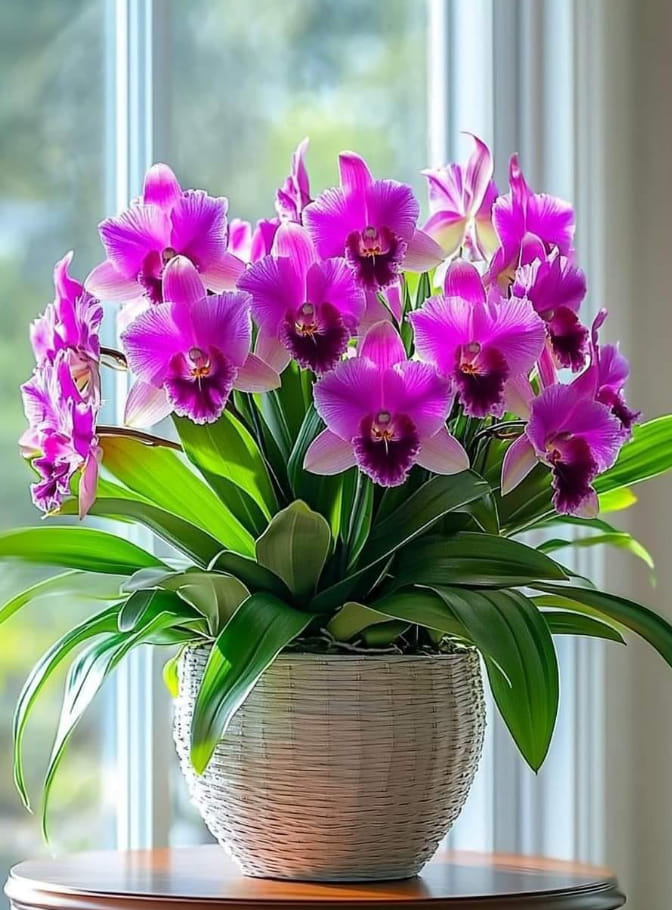The Cattleya Orchid is one of the most beloved orchid varieties, known for its breathtaking blooms and delightful fragrance. Its vibrant magenta flowers, often large and ruffled, can instantly elevate any space, making it a popular choice for orchid enthusiasts and interior decorators alike. If you’re looking to add a touch of exotic beauty and elegance to your home, caring for a Cattleya Orchid can be a rewarding experience.
Light Requirements
Cattleya orchids thrive in bright, indirect light. They require more light than some other orchids, so finding a location where they can receive plenty of filtered sunlight is key to promoting healthy growth and abundant blooms.
Ideal conditions: Place your Cattleya orchid near a window with bright, indirect light, such as an east- or west-facing window. You can use sheer curtains to diffuse the light if the direct sun becomes too intense.
Avoid: Direct exposure to harsh midday sunlight, which can scorch the delicate petals and leaves of the orchid. If the leaves start turning yellow or brown, it may indicate too much direct sunlight.
Watering Needs
Cattleya orchids require a precise watering schedule to thrive. Overwatering or allowing the orchid to sit in water can lead to root rot, so it’s essential to let the potting mix dry out between waterings.
Watering schedule: Water thoroughly when the potting mix begins to dry out, which usually happens every 7-10 days depending on your environment and the size of the pot. Be sure to water the orchid until water runs out of the drainage holes, but don’t let the plant sit in water.
Avoid: Waterlogging the plant. Make sure that the pot has sufficient drainage holes to allow excess water to escape. Cattleya orchids prefer to dry out between waterings, so let the soil feel dry to the touch before watering again.
Soil and Potting
For healthy root growth and drainage, it’s important to use the right potting medium for Cattleya orchids. These orchids are epiphytes, meaning they naturally grow on trees and rely on air circulation around their roots.
Ideal soil: Use a well-draining orchid mix, such as a mix of bark, perlite, or sphagnum moss, to ensure that the roots are not waterlogged and have plenty of airflow. Orchid mixes are specifically formulated to allow for quick drainage and prevent fungal or bacterial infections.
Avoid: Using regular potting soil, as it retains too much moisture and can suffocate the roots. Additionally, ensure that the pot has plenty of drainage holes.
Temperature and Humidity
Cattleya orchids prefer moderate temperatures and high humidity. These conditions mimic their natural habitat in tropical regions and help encourage healthy growth and beautiful blooms.
Ideal temperature: Keep the orchid in a space with temperatures between 65-80°F (18-27°C). These orchids can tolerate slight temperature fluctuations but should not be exposed to temperatures below 60°F (15°C), as they may become stressed.
Humidity: Cattleya orchids thrive in environments with 50-70% humidity. If the air in your home is dry, consider placing your orchid on a humidity tray, or regularly mist the plant to maintain the humidity level around it.
Avoid: Placing the orchid in areas with low humidity or placing it near air conditioners, heaters, or vents, as this can dry out the plant and stress it.
Fertilizing the Cattleya Orchid
Proper feeding is important to ensure that your Cattleya orchid produces strong growth and long-lasting blooms.
Fertilizer schedule: Feed the orchid every 2 weeks with a balanced, diluted orchid fertilizer during the growing season (typically spring and summer). Use a half-strength solution to avoid overfeeding, which could damage the plant.
Avoid: Over-fertilizing the orchid, as this can lead to salt buildup in the potting medium, causing harm to the roots. Reduce feeding during the dormant period in fall and winter when the orchid is not actively growing.
Repotting and Care Tips
Repotting is an essential part of orchid care, as it refreshes the growing medium and gives the roots space to grow. Cattleya orchids generally need to be repotted every 1-2 years, or when the potting medium begins to break down.
Repotting frequency: Repot your Cattleya orchid every 1-2 years or when the potting medium starts breaking down. This also provides an opportunity to check for any root rot or other issues.
Air circulation: Ensure that your orchid has good air circulation around its roots. If the plant is growing in a cramped pot or the potting medium is decomposing, it can lead to root rot or poor growth.
Care Tips for a Thriving Cattleya Orchid
Air Circulation: Cattleya orchids need plenty of airflow around their roots and foliage. Consider using a fan to promote air circulation, especially in a humid environment.
Cleaning: Wipe the leaves of your Cattleya orchid with a damp cloth to remove dust and dirt. This ensures the plant receives enough light and looks neat.
Flower Support: As the flowers bloom, they may become top-heavy. Consider supporting the flower spike with a soft stake or plant support to prevent the blooms from drooping.
Resting Period: After flowering, Cattleya orchids benefit from a rest period during which they should be watered less frequently. This allows the plant to conserve energy for the next bloom cycle.
Common Issues and Solutions
Yellow Leaves: If the leaves turn yellow, it could be a sign of too much sunlight or overwatering. Adjust the light exposure or watering frequency accordingly.
No Blooms: Lack of blooming can result from insufficient light, improper temperature, or overfeeding. Ensure your orchid gets enough light and maintain the appropriate temperature and humidity.
Pests: While generally pest-resistant, Cattleya orchids can occasionally be affected by mealybugs, aphids, or scale insects. If pests are present, treat the plant with insecticidal soap or wipe the affected areas with a cotton swab dipped in rubbing alcohol.
Conclusion
The Cattleya Orchid (Cattleya spp.) is a showstopper in any home, with its stunning, ruffled flowers and intoxicating fragrance. By providing the right care, including bright, indirect light, consistent watering, a well-draining potting mix, and regular fertilizing, you can enjoy the beauty of these magnificent orchids year after year. Whether you’re an experienced orchid grower or a beginner, the Cattleya orchid will reward your efforts with vibrant blooms and a touch of tropical elegance.
More Article You Might Like
-
Texas Toast Sloppy Joes: The Crunchy, Cheesy Upgrade You Didn’t Know You Needed
There’s something timeless about sloppy joes. For generations, this saucy, savory, and slightly sweet ground beef sandwich has been a go-to comfort food in American kitchens. It’s quick, filling, and family-friendly—perfect for busy weeknights. But what if we told you there’s a way to take this classic dish up a notch? Enter the Texas Toast…
-
Classic Pig Pickin’ Cake
When it comes to Southern desserts, few sweets shine as brightly as the Classic Pig Pickin’ Cake. This nostalgic cake, sometimes called a “Mandarin Orange Cake,” has roots deep in Southern tradition. It gets its playful name from its frequent appearance at pig pickin’s—Southern-style barbecue gatherings where communities come together to enjoy slow-cooked pork, sides,…
-
Lemon Garlic Butter Chicken with Creamy Parmesan Pasta
There’s something irresistible about the combination of tender, golden-browned chicken paired with a creamy pasta coated in Parmesan cheese. Add the brightness of lemon, the depth of garlic, and the richness of butter, and you have a recipe that feels indulgent yet approachable enough for a weeknight dinner. Lemon Garlic Butter Chicken with Creamy Parmesan…



